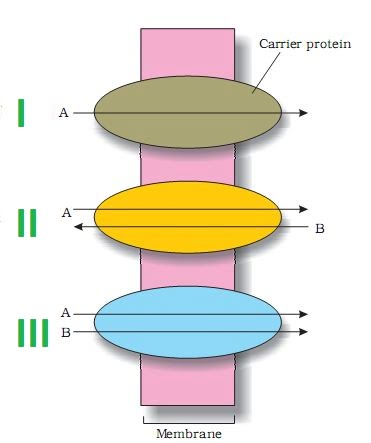Transport in Plants MCQ / Objective questions Chapter 11 Biology
Which of the following is not a part of the vascular system of plants?
- a. Xylem
- b. Phloem
- c. Tracheids
- d. Sapwood
In which direction plant transport its water
- a. From roots to stem
- b. From stem to roots
- c. From stem to stem
- d. From leaves to leaves
Absorption of minerals at root is:
- a. Active process
- b. Passive process
- c. Facilitated diffusion
- d. None
Facilitated diffusion is a energy independent diffusion across concentration gradient where some molecule help in the transport. Below is the picture showing three types of facilitated diffusion. Identify which is symport

- a. I
- b. II
- c. III
- d. None
Loading and unloading of sucrose into pholem is
- a. Energy independent process
- b. Energy-dependent process
- c. None
Following is not a xerophytic adaption to reduce loss of water
- a. Leaves modified into spikes
- b. Stoma on the lower portion of leaves
- c. Thick and spongy stem
- d. All of the above
In which of the following case plasmolysis of a cell will happen?
- a. a cell in isotonic medium
- b. a cell in a hypertonic solution
- c. a cell in a hypotonic solution
- d. b and c both
Xylem tracheids and vessels do not burst despite having hypertonic sap because
- a. Tracheids are dead tissues
- b. Lignified xylem fibers prevent bursting of xylem cells
- c. Living cells near xylem cells have more tonicity
- d. None
In humid atmosphere transpirational rate will be
- a. Higher
- b. Lower
- c. No effect
- d. stopped
In which of the following condition stomata will be open for exchange of gases?
- a. when turgor pressure of guard cells is high (turgid condition)
- b. when turgor pressure of guard cells is low (flaccid condition)
- c. both
- d. none
Which structure among these reduce loss of water to the plant?
- a. Stomata
- b. Hydathodes
- c. Thick cuticle
- d. All of the above
At higher altitude where atmospheric pressure remains lo, what will be the rate of transpiration?
- a. No effect
- b. Higher
- c. Lower
- d. Stopped
Which of the following is not true about guttation
- a. It occurs only at night when root pressure is high
- b. It happens through edge pores, hydathodes
- c. It is a drop of xylem sap
- d. Guttation increases transpiration rate
See also:
- The Living World MCQ
- Biological Classification MCQ
- Plant Kingdom MCQ
- Animal Kingdom MCQ
- Morphology of Flowering Plants MCQ
- Anatomy of Flowering Plants MCQ
- Structural Organisation in Animals MCQ
- Cell The Unit of Life MCQ
Transport in Plants MCQ / Objective questions Chapter 11 Biology
Ref: Chapter 11.